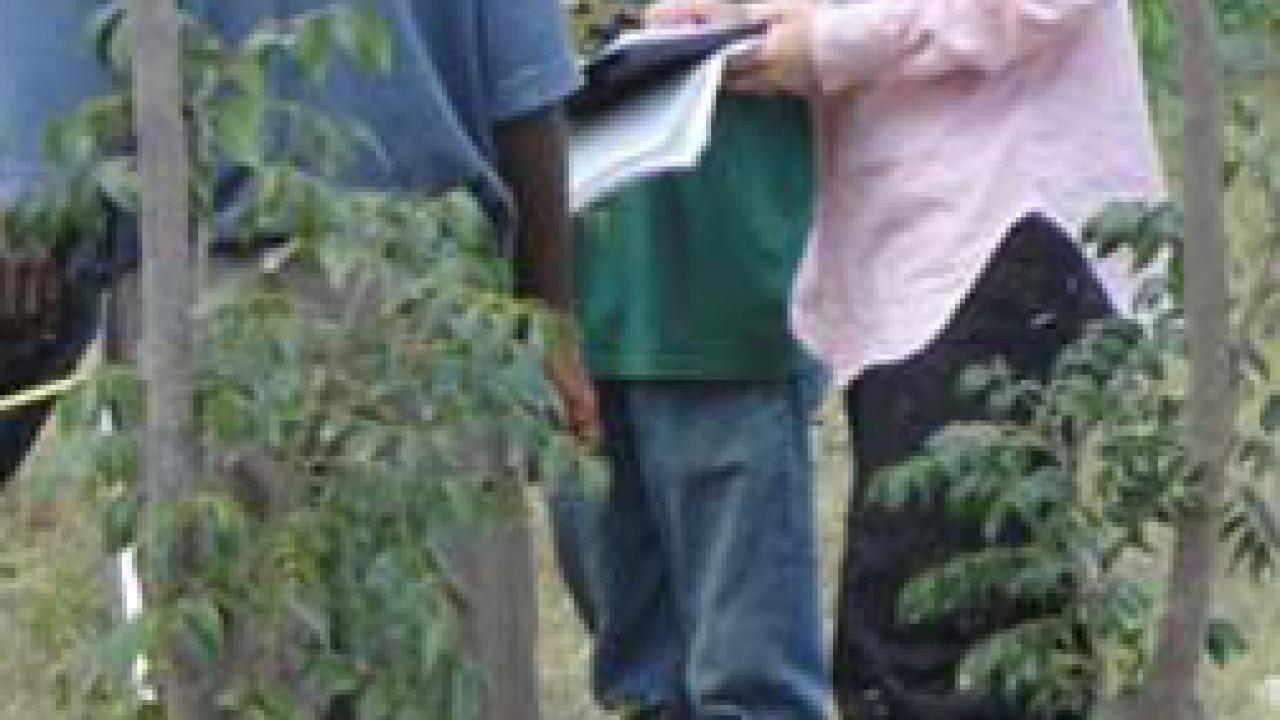Editor's note, April 16: As the UC system prepares to host a Haiti Summit on April 24, Dateline presents this essay by Department of Plant Sciences graduate student Starry Sprenkle, whose name you might recall from news reports after the Jan. 12 earthquake that ravaged Haiti. For two days after the quake, the UC Davis community worried about Sprenkle and her family — husband Erlantz Hyppolite and their 20-month-old daughter, Jasmine—until learning that all of them were safe. In this essay, first published last month (on LiveScience.com), Sprenkle describes life after the quake and her continuing research into sustainable tree farming. More information on her work is available online: ecologicalrestoration.info/gallery4.asp. New note, Aug. 10: Sprenkle describes more restoration work under a new grant here: http://workforhaiti.blogspot.com/2010_08_01_archive.html
By Starry Sprenkle
Two months ago, I was in “quarantine” with my Haitian husband’s family in their home above Port-au-Prince.
The chaos in the city, following the devastating earthquake of Jan. 12, forced us to stay close to the house, ration food and cut branches of trees to make charcoal for cooking. But our suffering was minimal compared with that of the city dwellers, who had witnessed entire neighborhoods leveled to rubble, crushing many loved ones. People were forced to live under sheet tents on the streets because they feared that the remaining structures would fall, and were terrorized by criminals who had escaped from ruined prisons.
For weeks, there was little medical care, and hardly any food aid reached the people, turning Haiti’s usually vibrant and bustling capital city — Port-au-Prince, the heart of the country for more than 100 years — into a dangerous and miserable hell.
One morning following the quake, I sat for a moment in Haiti’s Artibonite Valley and absorbed the peace around me. Legs crossed in a meditative stance, I was 1,000 feet above the valley floor, sitting on a slope covered in rocky soil that jabbed me through my jeans. The slope faced eroded mountains that extended up another 2,000 or so feet ahead of me, separating me from nightmare visions in Port-au-Prince.
This part of the country received very little direct damage, but has received a large number of refugees. My husband and I had trekked here a week before, our 20-month-old daughter in tow, to return to our home on the hospital campus where he works. I have been doing field research in ecology in Haiti for about six years.
We might have to evacuate in the next few months if the situation deteriorates, so I am collecting as much data as I can from plots that I planted as long as four years ago. With my National Science Foundation research budget, I had just purchased a GPS that I’m now using to mark plot locations, and tagging many of the trees for reference.
Having this mapping done now will make it a little less disastrous if I end up having to take some time off because of the aftermath of the quake. I had planned on spending at least another year doing this research.
But these worries were for a moment forgotten, sitting in the morning cool. As always, I wore long sleeves and a large hat to protect my fair skin against the strong sun later in the day. I appreciated the general lack of noise; I heard the shoes of my assistants as they walked through my research plot, calling out measurements of tree seedlings in Creole.
Across a small ravine, a solitary woman was harvesting firewood on a steep slope covered with small shrubs, and her machete’s “thwack, thwack” dominated the quiet scene.
I felt no animosity toward her, even though harvesting fuel for firewood is a continual source of deforestation here in Haiti. As in other developing countries, Haiti’s economic and environmental problems are completely intertwined. My research here focuses on ways to help farmers grow trees for profit, trying to answer such questions as: Which trees grow best where? Do trees grow differently, depending on what other species they are mixed with? Do existing trees help seedlings grow? How much can farmers expect to make from different tree cropping systems?
Mountain farmers in this region are among the poorest of Haiti’s poor and suffer from chronic malnutrition. The main goal of fostering sustainable tree farming is increasing the farmer’s incomes and health, but there will also be environmental benefits over time.
Among other benefits, the trees will slow erosion and increase soil fertility, provide habitat to the very rare local wildlife, increase water retention, and reduce downstream flooding (which repeatedly devastates the country).
Many have tried to do this before me, largely unsuccessfully. I hope that working in close collaboration with farmers — gaining a full understanding of their reality, and helping them throughout the 10-plus-year transition from the annual farming of corn and millet to the farming of shade-grown crops under trees — will give me a chance at success.
I developed this project and ran it for two years before becoming an NSF graduate research fellow. Now, I work for the project as a volunteer and get to use the staff as research assistants part-time in exchange for the other work I do for the project.
This work is more important than ever, to provide the increased food production necessary to feed the influx of refugees and to make up for the disrupted trade routes within the country and disrupted flow of imports that has followed the earthquake.
I’m hoping that I can get my hands on enough agricultural seeds this year to conduct a study on shade-grown crops. The banks haven’t been functioning since the quake, and Port-au-Prince was the only place in the country to purchase most major agricultural supplies. The country will slowly reorganize itself, hopefully for the better in the end, and it will certainly be a very interesting time to be here.
Media Resources
Clifton B. Parker, Dateline, (530) 752-1932, cparker@ucdavis.edu
